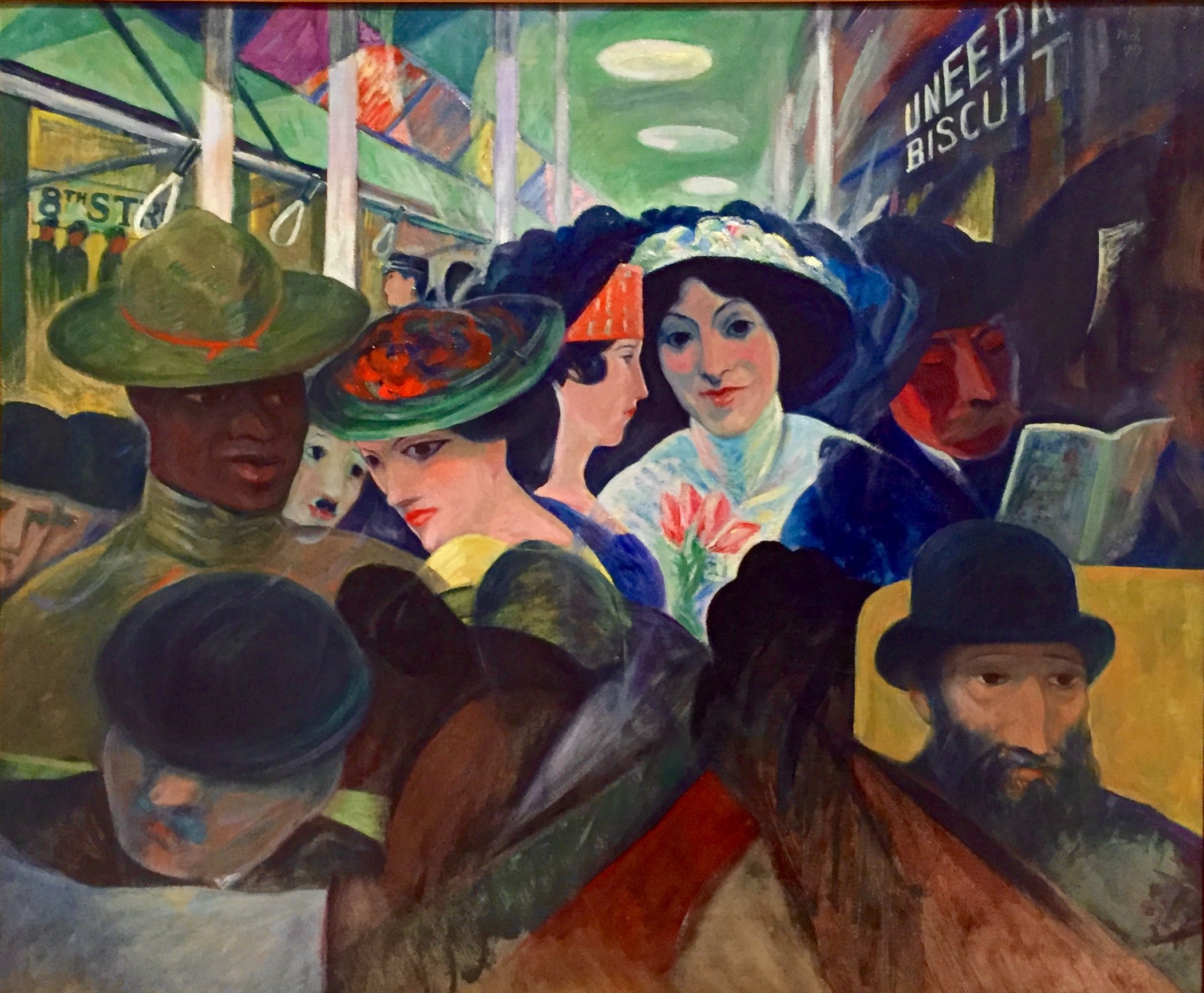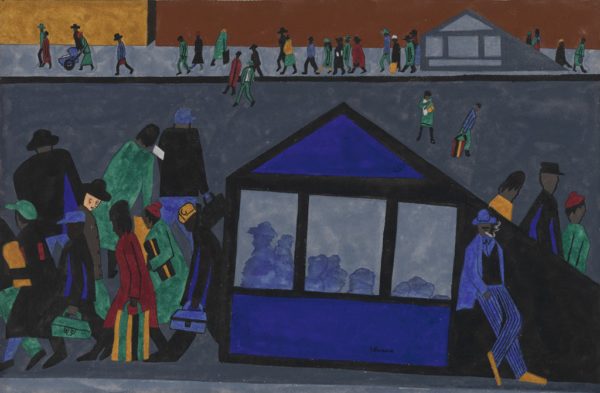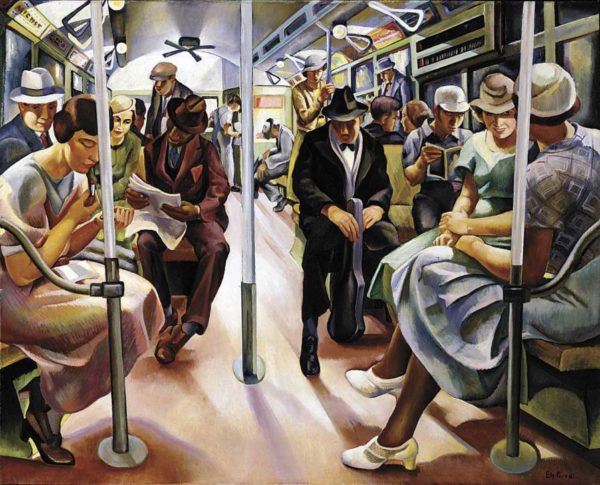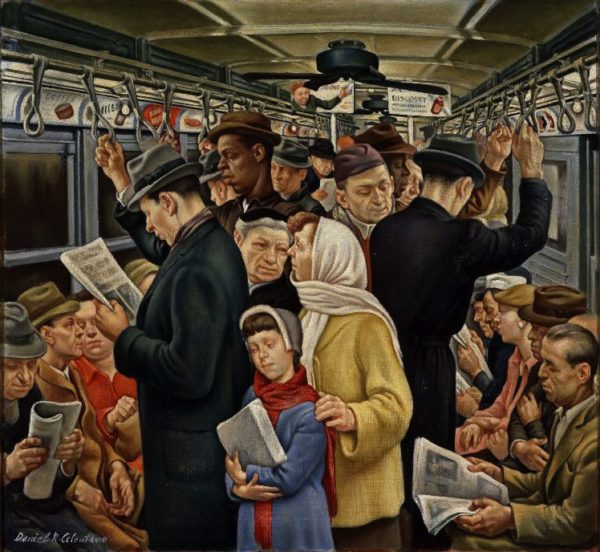Subway Rush Hour
by Langston Hughes
Mingled
breath and smell
so close
mingled
black and white
so near
no room for fear.

Hughes published Subway Rush Hour in 1951 part of “Montage of a Dream Deferred”. In “My Early Days in Harlem” 1963 he wrote of his arrival Harlem as a young man from the mid-West.
On a bright September morning in 1921, I came up out of the subway at 135th and Lenox into the beginnings of the Negro Renaissance. I headed for the Harlem Y.M.C.A. down the block, where so many new, young, dark, male arrivals in Harlem have spent early days. The next place I headed to that afternoon was the Harlem Branch Library just up the street. There, a warm and wonderful librarian, Miss Ernestine Rose, white, made newcomers feel welcome, as did her assistant in charge of the Schomburg Collection, Catherine Latimer, a luscious café au lait. That night I went to the Lincoln Theatre across Lenox Avenue where maybe one of the Smiths—Bessie, Clara, Trixie, or Mamie—was singing the blues. And as soon as I could, I made a beeline for Shuffle Along, the all-colored hit musical playing on 63rd Street in which Florence Mills came to fame.
I had come to New York to enter Columbia College as a freshman, but really why I had come to New York was to see Harlem. I found it hard a week or so later to tear myself away from Harlem when it came time to move up the hill to the dormitory at Columbia. That winter I spent as little time as possible on the campus. Instead, I spent as much time as I could in Harlem, and this I have done ever since. I was in love with Harlem long before I got there, and I still am in love with it. Everybody seemed to make me welcome. The sheer dark size of Harlem intrigued me. And the fact that at that time poets and writers like James Weldon Johnson and Jessie Fauset lived there, and Bert Williams, Duke Ellington, Ethel Walters, and Walter White, too, fascinated me. Had I been a rich young man, I would have bought a house in Harlem and built musical steps up to the front door, and installed chimes that at the press of a button played Ellington tunes.
Walter Pach’s oil painting is on display at World War 1 and American Art at The Pennsylvania Academy of Fine Arts. The exhibit is dedicated to exploring the ways in which American artists reacted to the First World War.
Pach was an important figure in the 20th century American art world more often remembered for his work as a critic and promoter than as an artist. He defended modern art against its critics and was instrumental in organizing the infamous and ground-breaking 1913 Armory show that so scandalized the traditional art world in New York. Pach wrote:
America was living of the canned foods of Art; there was fresh fruit and fresh meat on the tables of Paris and it wanted its share.
And that sharing meant seeing Marcel Duchamp’s Cubist-inspired Nude Descending a Staircase (described by Julian Street, an art critic for the New York Times, as “an explosion in a shingle factory”.) It also meant seeing Matisse, Van Gogh, Gauguin, Cezanne, and Picasso. Viewers at the show were shocked because they had never seen anything like it before.
Here is how Pach explained Cubism:
Our knowledge of objects depends on seeing them from different sides. Braque and Picasso paint them so; the recombination of the planes …(provides) the means for relating, one with the other, the phases of sight retained in the memory ….”
He created a stir in 1928 in the art world with Ananias, or The False Artist, where he castigated opportunistic artists and corruption in the art world. He chose one of John Singer Sargent’s society portraits – Lady Warwick and her Son 1905 – for the illustration.on the dust jacket of the book.
Pach was an early admirer of the work of emerging African-American artists among them Jacob Lawrence, Romare Beardon and Horace Pippin. In his capacity as advisor to the Shilling Fund, he arranged for Lawrence’s Subway: Home from Work to be given to the Virginia Museum of Fine Arts in 1944.

1943. Jacob Lawrence (1917 – 2000)


The featured image is also by Jacob Lawrence. It’s one of two models for the mural he designed for the Times Square subway station. The mural was commissioned in 1991 by the Metropolitan Transportation Authority’s Arts for Transit program and was installed in 2001. It’s a 36 feet wide mosaic tile work hanging on the mezzanine level near the Shuttle train.



Great Post
John Wade´s last blog post ..MySubwayCard Official Login And Registration At http://www.mysubwaycard.com